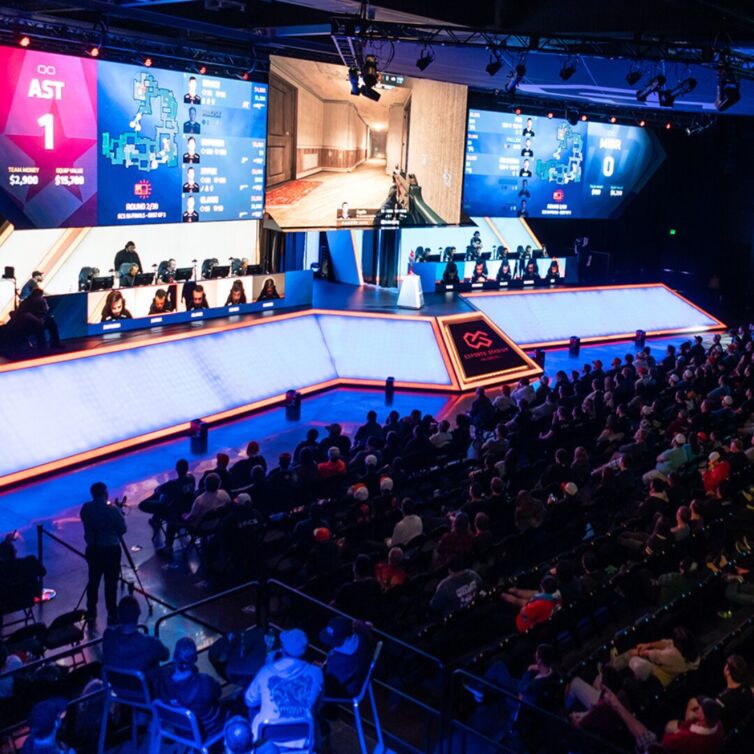Shaping the Game Day Experience with Acoustics
Stadium Acoustic Design Considerations | November 16, 2023
Football is a cherished American tradition, a sport that unites families, communities, and the entire nation. The impact of football on our lives is undeniable, and the stadiums where games take place play a crucial role in this shared experience.
While we often think of touchdowns, sacks, and exciting plays when we think of football, the sound within the stadium is an essential, though often overlooked, part of the game.

Stadium acoustics bring excitement to life and help to connect fans from all walks of life. “For people who’ve been to hundreds of games to people’s first game experience, it’s important to fine-tune acoustics, so we can create the memorable experiences and the sense of community that comes when you all hear the same sound,” BrightTree Studios’ Acoustics Lead, Josh Thede, PE, LEED AP BD+C, WELL AP says.
Designing For Several Experiences
When designing acoustics in stadiums, our focus is on the fan and player experience, the multiple uses of a stadium, and the gameday facilities attached or located in the end zones of these stadiums. While it turns into a lot of moving parts rather quickly, designing a stadium with the experience of concerts or other community events in mind will get more use out of this large investment.
“There’s such a wide range of stadiums and arenas for all sorts of different sporting events. Each stadium is going to be used for not only gamedays but for large concerts or other events,” Thede says.
Fan Experience
Luxury suites are a common feature in stadiums. Suites are designed to offer an exclusive fan experience, particularly for those who make significant contributions to sports organizations or teams. These donors pay a premium for their private suites, and it’s important that their experience matches their investment.
These suites are equipped with kitchens for catering, a staff ensuring donors are well taken care of, and a private experience for viewing the game.
To maintain a pleasant atmosphere, with so many things happening at once on gameday, it’s crucial to involve an acoustician from the very beginning of the design process.
One major concern is the noise generated in the suite kitchens. With cooking and serving, there can be a lot of noise that people don’t want to hear while viewing a game. The acoustician’s consulting is valuable in making sure this kitchen noise doesn’t disturb those using the suite with proper space planning.
“For people who’ve been to hundreds of games to people’s first game experience, it’s important to fine-tune acoustics, so we can create the memorable experiences and the sense of community that comes when you all hear the same sound.”
– Josh Thede, PE, LEED AP BD+C, WELL AP
Inside the suites, it’s also important to focus on room acoustics and sound isolation. These elements help keep conversations private and clear, so donors can have meaningful discussions without interference.
Thede says, “If a donor is in a suite having a million-dollar conversation with someone, it’s very important they clearly understand each other.”
Sound isolation is equally important to prevent unwanted external noise from disrupting the luxury experience. With TVs showing the game and announcer commentary, poor sound isolation could lead to an unwanted blend of game sounds and TV audio, damaging the overall luxury gameday experience.
Mother’s Rooms and Decompression Spaces
In contemporary stadiums, the concept of creating inclusive environments has expanded beyond luxury suites and stadium structures. The addition of spaces like decompression areas and mother’s rooms is becoming a standard practice, however, the thoughtful placement and design of these spaces are equally important.
When planning for these rooms, it’s crucial to ensure that they are not located near noisy areas. Sound isolation within these rooms is also a top priority. After all, these spaces are designed to provide comfort and privacy, so the acoustic environment plays a pivotal role in their functionality.
“We’re trying to create these spaces where everyone feels included and welcome, so figuring out where those rooms fit is important as well,” Thede says.
Shared Gameday Facilities
In recent years, we’ve witnessed a growing trend in colleges and professional stadiums sharing gameday facilities. As these multi-functional spaces continue to evolve, the consideration of acoustics becomes increasingly critical.
“The more we develop gameday facilities, the more we have to consider acoustics. Some programs are doing weight rooms in those gameday facilities, so considering space planning in those is important,” Thede says.
With the incorporation of weight rooms and other shared areas within these facilities, space planning must be considered. Often, these facilities serve as hubs where multiple sports teams engage in weight training and receive treatment from athletic trainers.
Simultaneously, these spaces will accommodate home and away team locker rooms, referee locker rooms, and a media room for post-game interviews.
With so many moving parts and several teams sharing the same space, the importance of thoughtful space planning cannot be overstated. Neglecting this aspect, along with failing to address sound isolation within these buildings, can lead to potentially uncomfortable situations.
“The player locker room might be next to the media conference room. Obviously if you’re celebrating after a big win, there’s going to be some loud music and yelling, meanwhile there’s some difficult questions being asked of the opposing coach in the media room next door.”
Open Air Stadiums
Open-air stadiums have a rich history, with the roots dating back to the Roman Amphitheaters.
Despite the centuries that have passed, the acoustic and sound design in stadiums hasn’t seen substantial innovation.
The main way to achieve proper acoustics in a stadium is to keep the distance away from the sound source as short as possible, while not blocking the line of sight.
Thede says, “Get the seating layout figured out first and get acoustics involved early, so we can work together to get the distances and the sight lines—the two most important things.”
This collaborative approach allows informed decisions on construction materials, such as concrete thickness. Thede says, “It can really elevate the experience from the beginning.”
Thinking about what the sound source is will help create the best stadium acoustics. Most modern-day stadiums have an AV system as their main sound source.
Thede says, “As soon as you get longer distances, you get more sound attenuation that’s quieter and the potential that you’re hearing the sound coming from multiple AV systems, which can bring muddy speech intelligibility.”
The shapes within the stadium are pivotal in determining the sound absorption capabilities.
Thede recommends favoring convex shapes over concave ones to diffuse sound effectively.
Tuning the AV system is crucial to prevent audio from overpowering the stadium and causing unwanted reverberations. In some cases, sound reflectors and absorbers can be used to fine-tune the acoustics and ensure a positive fan experience.
The Crowd
The crowd is an integral component of the stadium experience, both contributing to and affected by the acoustics of the venue.
“The crowd becomes a part of the sound absorption and how much room acoustics is going on inside a giant bowl, as well as being a noise source itself,” Thede says.
The number of people in the stadium, often wearing heavy coats and blankets during cooler weather, play a significant role in sound absorption.
The Stadium Shape
The shape of a stadium is a defining factor in shaping the auditory experience inside. Thede explains, “Theres no shape that’s best for acoustics. There are just different outcomes for different stadium shapes.”
When selecting the shape of a stadium, it’s essential to consider not only its aesthetic aspects but also the environmental and community noise implications.
If your vision is to have a stadium open on one side to symbolize the unity of the town and its sports teams, you will have to consider how the town will feel when a rock band books the same venue and plays past the noise curfew.
Stadium designs with overhangs at the top can present specific challenges. In these cases, sound tends to travel downward, bouncing off concrete surfaces and reverberating back up to the overhangs, resulting in less intelligible sound.
Outdoor stadiums are susceptible to the impact of weather and temperature on acoustics.
“The basic physics behind sound is that it’s the energy between the air molecules hitting each other and that’s how it transmits. The temperature, humidity, and wind directions can change how sound propagates,” Thede goes on to say, “The colder it is, the less energy in the air, so the sound has a little more lag and harder time transmitting.”
The process of tuning a stadium for sound in various weather conditions is very important, ensuring a consistent and enjoyable auditory experience for all.
Indoor stadiums
Indoor stadiums, though less traditional, yet often associated with some of the most iconic football teams, come with a unique set of acoustic challenges.
The ceilings are especially reflective and cause major reverberation issues. For indoor stadiums especially, acoustic consulting should be involved from the beginning of the design process.
The shape plays a pivotal role because sound has no way to escape. Sound absorption is highly important in these indoor facilities.
To tackle these challenges, indoor arenas need sound absorption materials strategically placed on ceilings, walls, and often behind the last row of seating. The objective is to mitigate sound reflections and reverberation, enhancing the environment for both players and spectators.
Unfortunately, some indoor stadiums have encountered acoustic issues that necessitated significant investments in remedial measures.
For instance, one NFL stadium initially constructed its roof in a straight line, causing sound to harshly reflect back down onto the field. This resulted in players complaining about the high-volume levels, causing the organization to invest in sound absorption materials for the ceiling. In hindsight, a more thoughtful initial acoustics-approved construction approach would have been a far more cost-effective solution.
While we focused primarily on football stadiums in this discussion, these acoustic considerations stay true to any type of stadium or arena. Design choices can affect the auditory and overall experience for athletes and fans on gamedays.
From the shape and layout of stadiums, the role of shared facilities, and the importance of considering the crowd, these considerations are vital in shaping the gameday experience. The early involvement of acousticians and the strategic design of these spaces are pivotal, serving not only to optimize the acoustics but also to elevate the overall fan experience, making stadium events truly memories for a lifetime.
Interested in reading more acoustics insights? Check out our article on the acoustics in the Las Vegas Sphere








